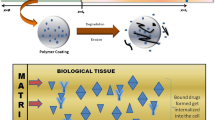Abstract
In this work some problems in drug delivery from solid systems were described in terms of transient mass balances with diffusion and solved by using FEM. Firstly, the solving codes were compared with known analytical solutions, available for simple problems (simple geometries, constant diffusivities). Then, models were written to describe more realistic systems (complex geometries, variable diffusivities). Eventually, the behaviors of some real drug delivery systems were successfully predicted.







Similar content being viewed by others
References
Siepmann J, Siepmann F (2008) Mathematical modeling of drug delivery. Int J Pharm 364:328–343
Higuchi T (1961) Rate of release of medicaments from ointment bases containing drugs in suspensions. J Pharm Sci 50:874–875
Crank J (1975) The mathematic of diffusion, 2nd edn. The Clarendon Press, Oxford
Peppas NA, Sahlin JJ (1989) A simple equation for the description of solute release. III. Coupling of diffusion and relaxation. Int J Pharm 57:169–172
Grassi M, Grassi G (2005) Mathematical modelling and controlled drug delivery: matrix systems. Curr Drug Deliv 2:97–116
Siepmann J, Ainaoui A, Vergnaud JM, Bodmeier R (1998) Calculation of the dimensions of drug-polymer devices based on diffusion parameters. J Pharm Sci 87(7):827–832
Carslaw HS, Jaeger JC (1959) Conduction of heat in solids, 2nd edn. The Clarendon Press, Oxford
Zhou Y, Wu XY (1997) Finite element analysis of diffusional drug release from complex matrix systems. I. Complex geometries and composite structures. J Control Release 49:277–288
Wu XY, Zhou Y (1998) Finite element analysis of diffusional drug release from complex matrix systems. II. Factors influencing release kinetics. J Control Release 51:57–71
Siepmann J, Kranz H, Bodmeier R, Peppas NA (1999) HPMC-matrices for controlled drug delivery: a new model combining diffusion, swelling, and dissolution mechanism and predicting the release kinetics. Pharm Res 16(11):1748–1756
Siepmann J, Peppas NA (2000) Hydrophilic matrices for controlled drug delivery: an improved mathematical model to predict the resulting drug release kinetics (the “sequential layer” model). Pharm Res 17:1290–1298
Grassi M, Colombo I, Lapasin R (2000) Drug release from an ensemble of swellable crosslinked polymer particles. J Control Release 68:97–113
Kiil S, Johansen Dam-K (2003) Controlled drug delivery from swellable hydroxypropylmethylcellulose matrices: model-based analysis of observed radial front movements. J Control Release 90:1–21
Goepferich A, Langer R (1995) Modeling monomer release from bioerodible polymers. J Control Release 33:55–69
Goepferich A, Langer R (1995) Modeling of polymer erosion in three dimensions: rotationally symmetric devices. AIChE J 41:2292–2299
Lapidus L, Pinder GF (1982) Numerical Solution of partial differential equation in science and engineering. Wiley, New York
COMSOL Multiphysics user’s guide (2007) ©COPYRIGHT 1994–2007 (by COMSOL AB)
Barba AA, D’Amore M, Chirico S, Lamberti G, Titomanlio G (2009) A general code to predict the drug release kinetics from different shaped matrices. Eur J Pharm Sci 36:359–368
Horcajada P, Ramila A, Perez-Pariente J, Vallet-Regì M (2004) Influence of pore size of MCM-41 matrices on drug delivery rate. Micropor Mesopor Mat 68:105–109
Grassi M, Lapasin R, Coviello T, Matricardi P, Di Meo C, Alhaique F (2009) Scleroglucan/borax/drug hydrogels: structure characterization by means of rheological and diffusion experiments. Carbohyd Polym 78(3):377–383
Author information
Authors and Affiliations
Corresponding author
Rights and permissions
About this article
Cite this article
Galdi, I., Lamberti, G. Drug release from matrix systems: analysis by finite element methods. Heat Mass Transfer 48, 519–528 (2012). https://doi.org/10.1007/s00231-011-0900-y
Received:
Accepted:
Published:
Issue Date:
DOI: https://doi.org/10.1007/s00231-011-0900-y




